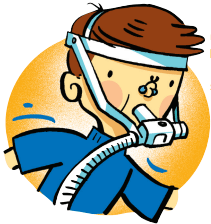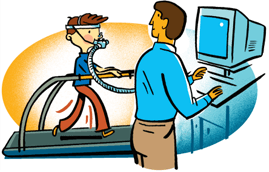
The first test your child will have is a spirometry (spy-ROM-a-tree) test to check his or her lung or "pulmonary" function. This test is done by having your child take a large breath and then breathe out very hard and fast through a tube connected to a computer.
- Your child might have to repeat this breathing test several times to get an accurate measurement.
- This test will be your child’s resting breathing function, or a "baseline" measurement.
Next, your child will be connected to several machines to take measurements before, during and after exercise. None of the machines used in this test will hurt your child in any way, and there are no needles used.
- A pulse oximeter—a small clip with a light on it—will be placed on your child’s fingertip to measure his or her blood oxygen level. The pulse ox will stay on during the test.
- Some small stickers called "electrodes" will be placed on your child’s chest and connected to an electrocardiogram (EKG) machine to measure your child’s heart rate and rhythm. The electrodes will stay in place during the test.
- A small mouthpiece, similar to a snorkel used in swimming, will be placed in your child’s mouth and connected to a machine. This machine will measure your child’s inhaled oxygen and exhaled carbon dioxide levels.
- A small padded nose clip will be placed on your child’s nose so he or she breathes only through the mouth.
When the machines are all connected, your child will be asked to walk briskly or jog on a treadmill.
- While your child walks, his or her heart rate, heart rhythm and blood oxygen level will be measured.
- An exercise physiologist—a technician with special training in exercise—will be in the room with your child during the entire test. A doctor also is available for any concerns during the test.
- Your child will be asked to walk or jog on the treadmill for about 6 to 8 minutes. The speed and grade of the treadmill will be controlled by the exercise physiologist.
- When the exercise part is finished, your child’s EKG will continue to be measured for 15 minutes.
- Your child also will repeat the spirometry breathing tests at 1 minute, 5 minutes, 10 minutes and 15 minutes after the exercise part of the test.
- Your child then will be given a bronchodilator inhaler to use, and a spirometry breathing test will be done again to see if the medication improves airflow.
- Your child’s blood pressure might be checked after the exercise testing.
- Your child then will be disconnected from the machines and the testing will be over.
- If your child’s doctor ordered a direct flexible laryngoscopy (lare-en-GOSS-ko-pee), it will be done after all of the exercise testing has been done. (See separate sheet for explanation of direct flexible laryngoscopy.)










